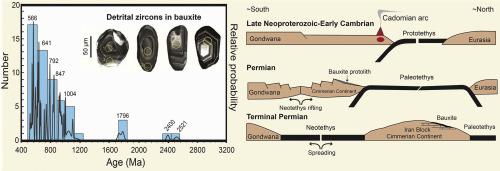Gondwana Research ( IF 6.1 ) Pub Date : 2021-02-09 , DOI: 10.1016/j.gr.2020.12.033 Gholam Hossein Shamanian , Keiko Hattori

|
When the Cimmerian Continent separated from Gondwana and drifted northward to equatorial latitudes, sedimentary rocks on the continent underwent intense weathering, resulting in the formation of bauxite deposits. Gheshlagh is one such bauxite deposit, located in the Alborz Mountains in northern Iran. The bauxite deposit at Gheshlagh, 12–18 m in thickness with a strike length > 4 km, is hosted by Permian strata and unconformably overlain by Early Triassic limestone. Detrital zircon grains in the bauxite deposit yielded U-Pb ages ranging from 2.5 Ga to 0.5 Ga, with most ages between ca. 0.9 Ga and 0.5 Ga. The detrital zircon grains with age populations between ca. 0.9 Ga and 0.6 Ga are tabular and rounded with sharp oscillatory zoning, and most likely derived from igneous rocks in the northern part of the Arabian-Nubian Shield. The detrital zircon grains with ages of ~1 Ga are long and rounded in shape with slightly obscure growth zoning and probably originated from metamorphic rocks of the Sinai basement in the northernmost part of the shield. Detrital zircon with ages between 1.8 and 2.5 Ga are smoothly rounded in shape with faint internal zoning, suggesting long transport from a metamorphosed source(s), possibly including the Saharan Metacraton, and/or the Kabul Block. The Gheshlagh deposit contains minor needle-like to prismatic-shaped zircon grains, with U-Pb ages ranging from ca. 571 to 521 Ma, corresponding to the timing of the Cadomian magmatic event in northern Gondwana. The occurrence of such proximal sourced zircons at Gheshlagh supports the notion that northern Gondwana was an active margin in response to southward subduction of Prototethys during late Neoproterozoic to Early Cambrian. Our data also suggest that the Cimmerian Continent was still located on the northern margin of Gondwana during deposition of the bauxite protolith in the Permian.
中文翻译:

伊朗阿尔伯兹山脉Gheshlagh铝土矿床碎屑锆石中记录的冈瓦纳北部新元古代演化
当Cimmerian大陆从Gondwana分离并向北漂移至赤道纬度时,该大陆上的沉积岩经历了强烈的风化作用,从而导致形成铝土矿床。Gheshlagh是一种这样的铝土矿床,位于伊朗北部的阿尔伯兹山脉。Gheshlagh的铝土矿床厚度为12–18 m,走向长度大于4 km,由二叠纪地层主控,早期三叠纪石灰岩覆盖不整合。铝土矿床中的碎屑锆石颗粒产生的U-Pb年龄范围为2.5 Ga至0.5 Ga,大多数年龄在约200到200 Ga之间。0.9 Ga和0.5 Ga。0.9 Ga和0.6 Ga呈板状并呈圆形,并带有明显的振荡带,最有可能来自阿拉伯-努比亚盾构北部的火成岩。年龄约1 Ga的碎屑锆石颗粒长且呈圆形,生长带带略微模糊,可能起源于盾构最北端的西奈基底的变质岩。年龄在1.8到2.5 Ga之间的碎屑锆石的形状呈光滑圆形,内部区域微弱,这表明从变质源(可能包括撒哈拉Metacraton和/或喀布尔地块)的长距离运输。Gheshlagh矿床含有少量的针状至棱形锆石晶粒,U-Pb年龄范围约为。571至521 Ma,对应于冈瓦纳北部卡多岩岩浆事件的发生时间。这样的近端锆石在盖什拉格(Gheshlagh)的出现支持了这样一种观念,即冈第纳瓦北部是新元古代晚期至寒武纪初期对原生动物向南俯冲的活跃边缘。我们的数据还表明,在二叠纪的铝土矿原生石沉积过程中,西美利亚大陆仍位于冈瓦纳的北边缘。


























 京公网安备 11010802027423号
京公网安备 11010802027423号